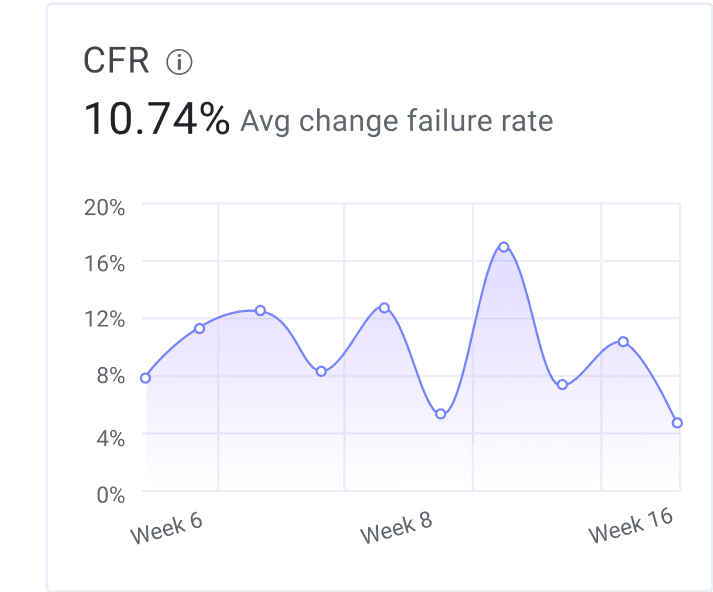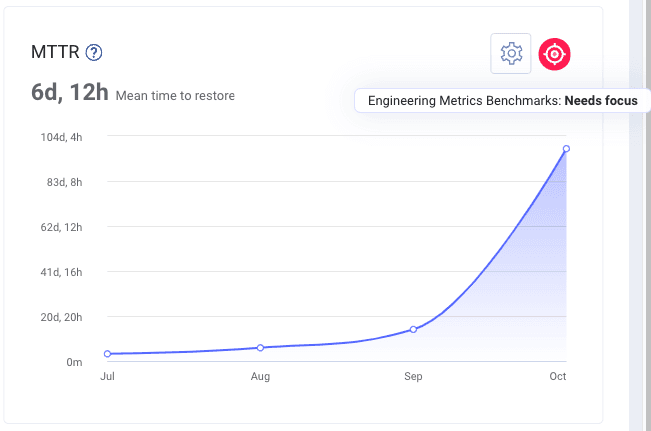Is today the day to invest in an Internal Developer Platform? We hear engineering leaders ask this question on a regular basis and we understand why. Your tools, processes, and workflows continue to get more complex, and maintaining developer productivity often feels like an uphill battle against this complexity.
One tool adding to that complexity is the Internal Developer Platform (IDP): a centralized hub for resources, tools, and processes that improve developer experience. But how do you know if the added complexity is worth it for your organization?
This article covers the most significant indicators that you need to start investing in an IDP and how to measure that investment.
What is an Internal Developer Platform?
An Internal Developer Platform is a centralized platform that provides developers easy access to all the tools, services, documentation, and workflows needed to build, deploy, and maintain software efficiently. It serves as a single pane of glass for managing developer experience and reducing friction in complex environments.
Key features include:
- Self-Service Capabilities: Automate access to infrastructure, CI/CD pipelines, and shared services, enabling developers to focus on coding.
- Centralized Knowledge Base: Provide a home for documentation, APIs, and best practices, fostering collaboration and reducing onboarding time.
- Standardization: Enforce organizational standards for tooling, security, and compliance.
- Metrics and Insights: Track engineering productivity and system health to optimize workflows.
Backstage, OpsLevel, and Port are some of the leading Internal Developer Platforms, and a growing number of engineering leaders want to understand if it’s time to invest in one of them. Here are seven key signs that it might be time to invest in an Internal Developer Platform to improve developer experience.
1. Tool Fragmentation is Creating Friction
Tool fragmentation can significantly hinder developer productivity, leading to inefficiencies and frustration across teams. When tools are scattered and workflows need more cohesion, developers spend more time navigating complexity than writing code.
Signs to watch for:
- Developers spend excessive time switching between tools to access documentation, CI/CD pipelines, cloud resources, or internal services.
- Onboarding new hires is sluggish because they can’t quickly locate resources or understand workflows.
- Efficiency metrics vary greatly between repos, teams, or projects.
How an IDP helps:
An integrated portal consolidates resources, standardizes processes, and minimizes cognitive load. With a single source of truth, developers spend more time coding and less time hunting for information.
2. Teams are Inefficient at Knowledge Sharing
Knowledge-sharing inefficiencies can hamper team productivity and lead to significant delays in the development lifecycle. When knowledge is fragmented or inaccessible, teams often waste time searching for information or re-inventing solutions to common problems, stifling innovation and collaboration.
Signs to watch for:
- Knowledge is siloed within teams or scattered across disparate systems.
- Teams frequently ask for help with self-serve tasks like accessing internal APIs, configuring test environments, or provisioning infrastructure.
- Code reviews are impeded by manual processes and intensive reworks, which result from a lack of consistent norms and practices.
How an IDP helps:
An IDP improves collaboration and autonomy by centralizing technical documentation, APIs, and workflows. It also reduces interruptions by enabling self-service access to critical resources.
3. Developers Experience Bottlenecks in Self-Service Capabilities
Self-service capabilities are a critical enabler for developer autonomy and efficiency. When developers must depend on platform teams for routine tasks or navigate complex, inaccessible automation, bottlenecks inevitably arise. These delays hinder productivity and strain platform teams, creating a cycle of inefficiency.
Signs to watch for:
- Developers rely heavily on platform teams to manually provision environments, debug infrastructure, or configure tools.
- Automation exists but is difficult for developers to access or navigate.
- Longer cycle times for teams that need to create or modify platform services frequently.
How an IDP helps:
An IDP brings self-service functionality to the forefront, enabling developers to provision resources, access tooling, and resolve issues without unnecessary delays.
4. You Lack Visibility into Engineering Processes
Engineering processes can become opaque as organizations grow, making identifying inefficiencies or assessing team productivity difficult. Without real-time visibility, you’ll be unable to make data-driven decisions, and your teams will lack insights to streamline collaboration.
Signs to watch for:
- Leadership struggles to get real-time insights into team productivity, deployment frequencies, or key metrics like DORA.
- Teams need more visibility into the lifecycle of their work, from ideation to deployment.
- The organization can’t identify the biggest bottlenecks in the software delivery process.
How an IDP helps:
Developer portals integrate with delivery pipelines and software engineering intelligence platforms to provide metrics and dashboards. This transparency helps leaders make informed decisions and empowers teams to track progress more effectively.
5. Teams are Misaligned
Misalignment among teams can create unnecessary friction and slow down development processes. When developers, operations, and security teams work with conflicting expectations or unclear standards, it leads to confusion, delays, and frustration. Establishing alignment across these groups is essential for maintaining productivity and meeting organizational goals.
Signs to watch for:
- Friction between developers, operations, and security teams over processes and policies.
- Confusion about compliance requirements or infrastructure standards.
- A lack of standardization during the merge process resulting in manual friction.
How an IDP helps:
With built-in compliance checks, deployment guardrails, and shared standards, an IDP reduces friction and fosters alignment. Teams can focus on their work without worrying about compliance or cross-functional conflicts.
6. You’re Experiencing Scaling Issues
Scaling an engineering organization comes with unique challenges. Maintaining cohesion, avoiding duplicated efforts, and ensuring consistent onboarding can become increasingly difficult as teams grow. Without the right systems in place, scaling can strain platform teams and lead to inefficiencies across the board.
Signs to watch for:
- Onboarding new teams or supporting new services strains your platform team and slows development.
- Growing team sizes result in duplicated efforts or conflicts over shared resources.
- New team members need more context for team norms and expected working behaviors, leading to expectations mismatches.
How an IDP helps:
An IDP scales knowledge and tooling across teams, ensuring efficient growth. It provides a unified platform where teams can collaborate without duplicating efforts or stepping on each other’s toes.
7. You Want to Benchmark Against Industry Standards
Falling behind on tooling, practices, or DevEx can lead to talent attrition and missed opportunities. By understanding where your organization stands and adopting proven solutions, you can ensure your engineering team remains competitive and productive.
Signs to watch for:
- Competitors or industry leaders are using Internal Developer Platforms to boost developer productivity.
- Developers are requesting modern tooling to stay competitive and meet industry standards.
- You don’t clearly understand what “good” DevEx looks like.
How an IDP helps:
Investing in an IDP future-proofs your engineering organization. It keeps your tools and processes aligned with industry benchmarks, ensuring you retain top talent and stay ahead of the competition.
The 3 Key Metrics to Track to Measure Internal Developer Platform Impact
Quantitative metrics can provide clear insights into inefficiencies and bottlenecks in developer workflows. Cycle time, Change Failure Rate (CFR), and Mean Time To Recovery (MTTR) can all provide insights into how an IDP impacts engineering performance.
Cycle Time
Measure the time it takes for a code change to progress from idea to production. If cycle times are consistently long due to process inefficiencies or clarity of ownership, an IDP could help by centralizing information and automating workflows. You should also break cycle time down into its component parts (lead, pickup, review, and deploy times) to get a granular view of software delivery bottlenecks at the team level.

Change Failure Rate (CFR)
CFR measures the percentage of changes deployed to production that result in a failure requiring remediation, such as a rollback, hotfix, or patch. High CFR often indicates inefficiencies in processes, testing, or communication. An IDP can reduce CFR by centralizing resources like CI/CD pipelines, quality gates, and deployment guidelines, ensuring that changes meet higher standards before reaching production.

MTTR (Mean Time to Recovery)
MTTR measures how long it takes to resolve production incidents. Delays often stem from difficulty locating the right tools, documentation, or on-call personnel: problems that an IDP can mitigate by consolidating resources. You should log incident resolution times in a software engineering intelligence platform and compare MTTR trends across different teams or services to identify services that take more effort to restore following a failure.

Is It Time to Invest in an Internal Developer Platform?
If any of the seven signs outlined in this article sound familiar, it may be time to consider an IDP. The complexity of modern software development isn't going away. In fact, it's only increasing. If left unaddressed, tool fragmentation, misaligned teams, and self-service bottlenecks can create hidden costs that sap productivity, delay projects, and frustrate developers.
An IDP offers a proactive solution, acting as a unifying layer that streamlines developer experience, enhances autonomy, and scales with your organization's growth. It turns scattered resources into a centralized hub, empowering developers to spend more time coding and less time searching, waiting, or reworking. An IDP isn’t just another tool, it’s a strategic enabler that can help you build faster, scale smarter, and compete more effectively in an increasingly complex software landscape.


![2025 Software Engineering Benchmarks [Dec Update]](https://assets.linearb.io/image/upload/v1733950346/2025_Software_Engineering_Benchmarks_Dec_Update_dbb686bd59.png)


